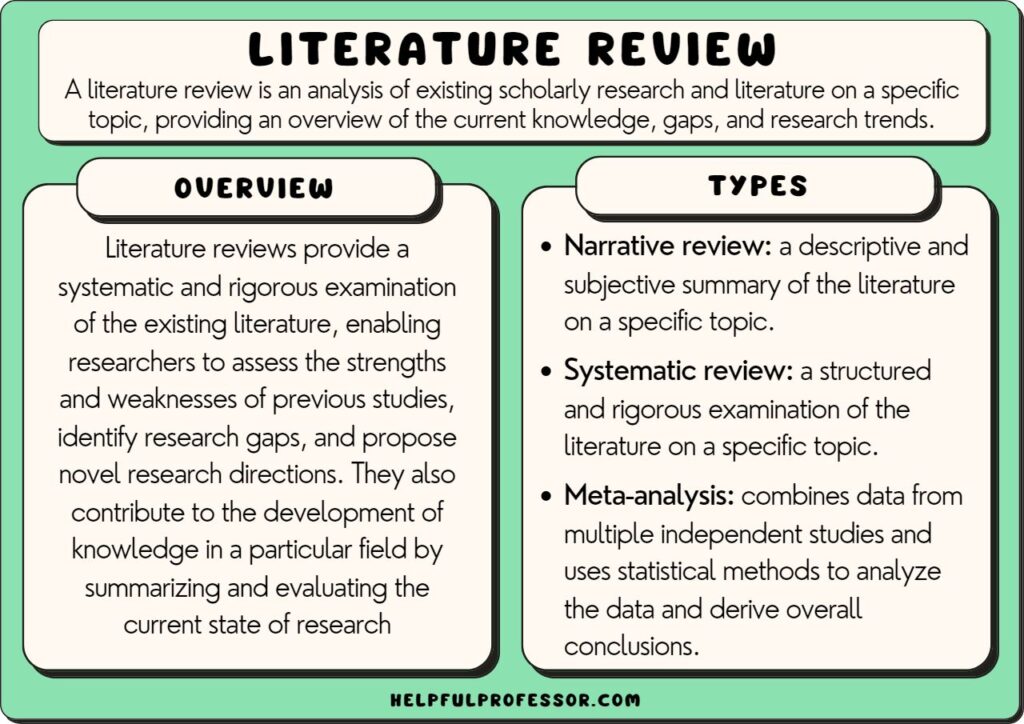

Written by Chris Drew (PhD)

Dr. Chris Drew is the founder of the Helpful Professor. He holds a PhD in education and has published over 20 articles in scholarly journals. He is the former editor of the Journal of Learning Development in Higher Education. [Image Descriptor: Photo of Chris]
| December 6, 2023
Literature reviews are a necessary step in a research process and often required when writing your research proposal. They involve gathering, analyzing, and evaluating existing knowledge about a topic in order to find gaps in the literature where future studies will be needed.
Ideally, once you have completed your literature review, you will be able to identify how your research project can build upon and extend existing knowledge in your area of study.
Generally, for my undergraduate research students, I recommend a narrative review, where themes can be generated in order for the students to develop sufficient understanding of the topic so they can build upon the themes using unique methods or novel research questions.
If you’re in the process of writing a literature review, I have developed a literature review template for you to use – it’s a huge time-saver and walks you through how to write a literature review step-by-step:
Contents showFor the following types of literature review, I present an explanation and overview of the type, followed by links to some real-life literature reviews on the topics.
Also known as a traditional literature review, the narrative review provides a broad overview of the studies done on a particular topic.
It often includes both qualitative and quantitative studies and may cover a wide range of years.
The narrative review’s purpose is to identify commonalities, gaps, and contradictions in the literature.
I recommend to my students that they should gather their studies together, take notes on each study, then try to group them by themes that form the basis for the review (see my step-by-step instructions at the end of the article).
Example Study
Title: Communication in healthcare: a narrative review of the literature and practical recommendations
Citation: Vermeir, P., Vandijck, D., Degroote, S., Peleman, R., Verhaeghe, R., Mortier, E., … & Vogelaers, D. (2015). Communication in healthcare: a narrative review of the literature and practical recommendations. International journal of clinical practice, 69(11), 1257-1267.
Overview: This narrative review analyzed themes emerging from 69 articles about communication in healthcare contexts. Five key themes were found in the literature: poor communication can lead to various negative outcomes, discontinuity of care, compromise of patient safety, patient dissatisfaction, and inefficient use of resources. After presenting the key themes, the authors recommend that practitioners need to approach healthcare communication in a more structured way, such as by ensuring there is a clear understanding of who is in charge of ensuring effective communication in clinical settings.
Other Examples
This type of literature review is more structured and rigorous than a narrative review. It involves a detailed and comprehensive plan and search strategy derived from a set of specified research questions.
The key way you’d know a systematic review compared to a narrative review is in the methodology: the systematic review will likely have a very clear criteria for how the studies were collected, and clear explanations of exclusion/inclusion criteria.
The goal is to gather the maximum amount of valid literature on the topic, filter out invalid or low-quality reviews, and minimize bias. Ideally, this will provide more reliable findings, leading to higher-quality conclusions and recommendations for further research.
You may note from the examples below that the ‘method’ sections in systematic reviews tend to be much more explicit, often noting rigid inclusion/exclusion criteria and exact keywords used in searches.
Example Study
Title: The importance of food naturalness for consumers: Results of a systematic review
Citation: Roman, S., Sánchez-Siles, L. M., & Siegrist, M. (2017). The importance of food naturalness for consumers: Results of a systematic review. Trends in food science & technology, 67, 44-57.
Overview: This systematic review included 72 studies of food naturalness to explore trends in the literature about its importance for consumers. Keywords used in the data search included: food, naturalness, natural content, and natural ingredients. Studies were included if they examined consumers’ preference for food naturalness and contained empirical data. The authors found that the literature lacks clarity about how naturalness is defined and measured, but also found that food consumption is significantly influenced by perceived naturalness of goods.
Other Examples
This is a type of systematic review that uses statistical methods to combine and summarize the results of several studies.
Due to its robust methodology, a meta-analysis is often considered the ‘gold standard’ of secondary research, as it provides a more precise estimate of a treatment effect than any individual study contributing to the pooled analysis.
Furthermore, by aggregating data from a range of studies, a meta-analysis can identify patterns, disagreements, or other interesting relationships that may have been hidden in individual studies.
This helps to enhance the generalizability of findings, making the conclusions drawn from a meta-analysis particularly powerful and informative for policy and practice.
Example Study
Title: Cholesterol and Alzheimer’s Disease Risk: A Meta-Meta-Analysis
Citation: Sáiz-Vazquez, O., Puente-Martínez, A., Ubillos-Landa, S., Pacheco-Bonrostro, J., & Santabárbara, J. (2020). Cholesterol and Alzheimer’s disease risk: a meta-meta-analysis. Brain sciences, 10(6), 386.
Overview: This study examines the relationship between cholesterol and Alzheimer’s disease (AD). Researchers conducted a systematic search of meta-analyses and reviewed several databases, collecting 100 primary studies and five meta-analyses to analyze the connection between cholesterol and Alzheimer’s disease. They find that the literature compellingly demonstrates that low-density lipoprotein cholesterol (LDL-C) levels significantly influence the development of Alzheimer’s disease.
Other Examples
Most undergraduate students conducting a capstone research project will be writing narrative reviews. Below is a five-step process for conducting a simple review of the literature for your project.
Literature reviews don’t have to be as scary as they seem. Yes, they are difficult and require a strong degree of comprehension of academic studies. But it can be feasibly done through following a structured approach to data collection and analysis. With my undergraduate research students (who tend to conduct small-scale qualitative studies), I encourage them to conduct a narrative literature review whereby they can identify key themes in the literature. Within each theme, students can critique key studies and their strengths and limitations, in order to get a lay of the land and come to a point where they can identify ways to contribute new insights to the existing academic conversation on their topic.
Ankrah, S., & Omar, A. T. (2015). Universities–industry collaboration: A systematic review. Scandinavian Journal of Management, 31(3), 387-408.
Asghari, P., Rahmani, A. M., & Javadi, H. H. S. (2019). Internet of Things applications: A systematic review. Computer Networks, 148, 241-261.
Dyrbye, L., & Shanafelt, T. (2016). A narrative review on burnout experienced by medical students and residents. Medical education, 50(1), 132-149.
Geiger, J. L., Steg, L., Van Der Werff, E., & Ünal, A. B. (2019). A meta-analysis of factors related to recycling. Journal of environmental psychology, 64, 78-97.
Martin, F., Sun, T., & Westine, C. D. (2020). A systematic review of research on online teaching and learning from 2009 to 2018. Computers & education, 159, 104009.
Mavilidi, M. F., Ruiter, M., Schmidt, M., Okely, A. D., Loyens, S., Chandler, P., & Paas, F. (2018). A narrative review of school-based physical activity for enhancing cognition and learning: The importance of relevancy and integration. Frontiers in psychology, 2079.
Patterson, G. T., Chung, I. W., & Swan, P. W. (2014). Stress management interventions for police officers and recruits: A meta-analysis. Journal of experimental criminology, 10, 487-513.
Reith, T. P. (2018). Burnout in United States healthcare professionals: a narrative review. Cureus, 10(12).
Ritchie, S. J., & Tucker-Drob, E. M. (2018). How much does education improve intelligence? A meta-analysis. Psychological science, 29(8), 1358-1369.
Roman, S., Sánchez-Siles, L. M., & Siegrist, M. (2017). The importance of food naturalness for consumers: Results of a systematic review. Trends in food science & technology, 67, 44-57.
Sáiz-Vazquez, O., Puente-Martínez, A., Ubillos-Landa, S., Pacheco-Bonrostro, J., & Santabárbara, J. (2020). Cholesterol and Alzheimer’s disease risk: a meta-meta-analysis. Brain sciences, 10(6), 386.
Vermeir, P., Vandijck, D., Degroote, S., Peleman, R., Verhaeghe, R., Mortier, E., … & Vogelaers, D. (2015). Communication in healthcare: a narrative review of the literature and practical recommendations. International journal of clinical practice, 69(11), 1257-1267.
Wisniewski, B., Zierer, K., & Hattie, J. (2020). The power of feedback revisited: A meta-analysis of educational feedback research. Frontiers in Psychology, 10, 3087.
Yli-Huumo, J., Ko, D., Choi, S., Park, S., & Smolander, K. (2016). Where is current research on blockchain technology?—a systematic review. PloS one, 11(10), e0163477.
Zestcott, C. A., Blair, I. V., & Stone, J. (2016). Examining the presence, consequences, and reduction of implicit bias in health care: a narrative review. Group Processes & Intergroup Relations, 19(4), 528-542